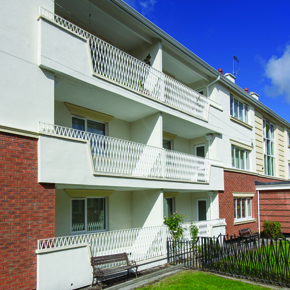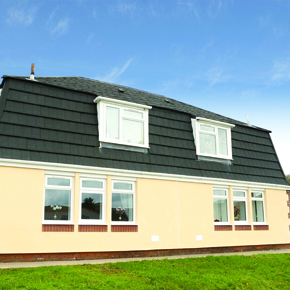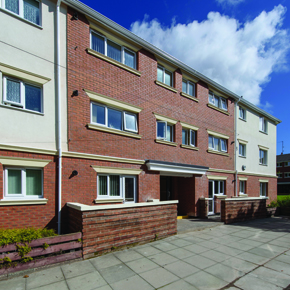
Insulation that achieves the best of all worlds
External wall insulation plays a key part, not just in improving thermal efficiency and alleviating issues with fuel poverty, but also in enhancing the attractiveness of existing housing stock and regenerating communities.
Darren Snaith, director of refurbishment and regeneration at ROCKWOOL, explains how to transform buildings and communities for the better…
 According to Government figures, some 625,000 homes per year need to be brought to near-zero carbon emissions by 2050 to comply with targets in the Climate Change Act; for example, achieving EPC ratings of at least band B for all dwellings by this date.
According to Government figures, some 625,000 homes per year need to be brought to near-zero carbon emissions by 2050 to comply with targets in the Climate Change Act; for example, achieving EPC ratings of at least band B for all dwellings by this date.
At the same time, official figures suggest there are currently just over 2.3 million households living in fuel poverty in England, approximately 10% of the UK’s population. A large majority of these households are social housing which is in dire need of renovation to deliver improved thermal and aesthetic performance.
Actions being taken to resolve these issues by social housing providers typically involve External Wall Insulation (EWI). With stone wool external wall insulation, blocks of insulation are mechanically fixed onto the external fabric of a building and then rendered to provide a cost-effective solution in a range of different applications.
Stone wool EWI
This type of EWI is proven to achieve high levels of thermal insulation, eliminating cold bridging issues and easily achieves a minimum refurbishment U-value target of 0.3W/m2K.
It is also non-combustible, both in bulk storage and when installed. This non-combustibility is often an important consideration, given that social housing tenants often remain in occupation as EWI is applied on projects.
An additional benefit is that this type of stone wool system still allows buildings to breathe, preventing surface and interstitial condensation, by keeping the temperature throughout the cross-section of the wall structure above dew point.
Versatile aesthetics
EWI systems are also known and installed for their versatility. They can be applied to standard and many non–standard constructions and are typically available in a wide range of different coloured renders and finishes, including brick and dash. This versatility enables architects to meet often challenging Local Planning Requirements.
 On a recent project with One Vision Housing at the Hornby Flats Estate in Litherland, ROCKWOOL worked with architect HLP to develop such a solution. The development comprises eight, three-storey buildings in a garden setting, where the original design and construction had caused substantial issues with cold bridging.
On a recent project with One Vision Housing at the Hornby Flats Estate in Litherland, ROCKWOOL worked with architect HLP to develop such a solution. The development comprises eight, three-storey buildings in a garden setting, where the original design and construction had caused substantial issues with cold bridging.
HLP’s design solution was based on over-cladding the flats with EWI that combined thermally robust detailing with contemporary classical architecture. HLP worked closely with One Vision Housing to meet its demand that real brickwork would be visible as part of the external wall insulation, especially since the surrounding streets are traditional brick Victorian terraces.
ROCKWOOL’s BrickShield system offered the solution, in combination with the REDArt Silicone render system. The result is a thermally efficient scheme where the elevations retain their balance and proportion but, in doing so, create a sense of grandeur more befitting their garden setting.
Social benefits
Perhaps just as important as these benefits are the significant social advantages that EWI can bring. In 2015 LSE Housing and Communities produced High Rise Hope Revisited, a report examining the social implications of whole building energy efficiency refurbishments, including EWI, in residential tower blocks.
Based on research conducted at the Edward Woods estate in Shepherds Bush, London, the report found that upgrading work carried out across 754 flats in three 23-storey tower blocks had enhanced the quality of life and living conditions for residents, with aesthetic improvements instilling a sense of pride within the community.
High Rise Hope Revisited shows that while this type of refurbishment scheme can help alleviate fuel poverty, the transformation of the visual appearance of Edward Woods on both an estate and wider neighbourhood scale had improved the sense of well-being of residents, making the area a more attractive environment to live.
The installation of EWI as part of wider regeneration schemes can not only help extend the life of existing buildings for the future but also ensure long-established communities are able to enjoy improved conditions in a secure, well maintained place to live.
Find out more in the May 2016 issue of ABC+D Magazine
Contact:
ROCKWOOL,
Pencoed,
Bridgend,
United Kingdom,
CF35 6NY
Phone: 01635 862621
Fax: 01656 862302
Visit Supplier's page
Latest news

21st February 2025
ASSA ABLOY EMEIA: Save valuable time and money with a seamless switch to programmable digital keys
In 2025, access management can be a whole lot easier. By making access part of their digital processes, businesses can put time-consuming key management and the cost of changing the locks firmly behind them. Making this switch is a lot easier than many people think, as ASSA ABLOY explains here…
Posted in Access Control & Door Entry Systems, Architectural Ironmongery, Articles, Building Industry News, Building Products & Structures, Building Services, Doors, Facility Management & Building Services, Health & Safety, Information Technology, Innovations & New Products, Retrofit & Renovation, Security and Fire Protection
21st February 2025
Showersave supports industry leaders in addressing Part L and Part G regulations
Showersave has sponsored and participated in a recent Building Insights LIVE roundtable on ‘Water & Energy Saving Innovations in New Build Housing’.
Posted in Articles, Bathrooms & Toilets, Bathrooms, Bedrooms & Washrooms, Building Associations & Institutes, Building Industry Events, Building Industry News, Building Products & Structures, Building Regulations & Accreditations, Building Services, Exhibitions and Conferences, Interiors, Pipes & Fittings, Plumbing, Retrofit & Renovation, Sustainability & Energy Efficiency
21st February 2025
GEZE: The importance of Specifying High Quality Door Closers on Fire Doors
Andy Howland, Sales & Marketing Director at GEZE UK, discusses why specifying high quality door closers on fire doors is important…
Posted in Access Control & Door Entry Systems, Accessibility, Architectural Ironmongery, Articles, Building Industry News, Building Products & Structures, Building Regulations & Accreditations, Building Services, Doors, Facility Management & Building Services, Health & Safety, Posts, Restoration & Refurbishment, Retrofit & Renovation, Security and Fire Protection
21st February 2025
Insight Data achieves ISO9001 recertification with zero non-conformities
Leading industry data specialist, Insight Data, has successfully achieved the prestigious recertification for ISO9001 with zero non-conformities for the fourth consecutive year.
Posted in Articles, Building Industry News, Building Regulations & Accreditations, Building Services, Information Technology, Research & Materials Testing
 Sign up:
Sign up: